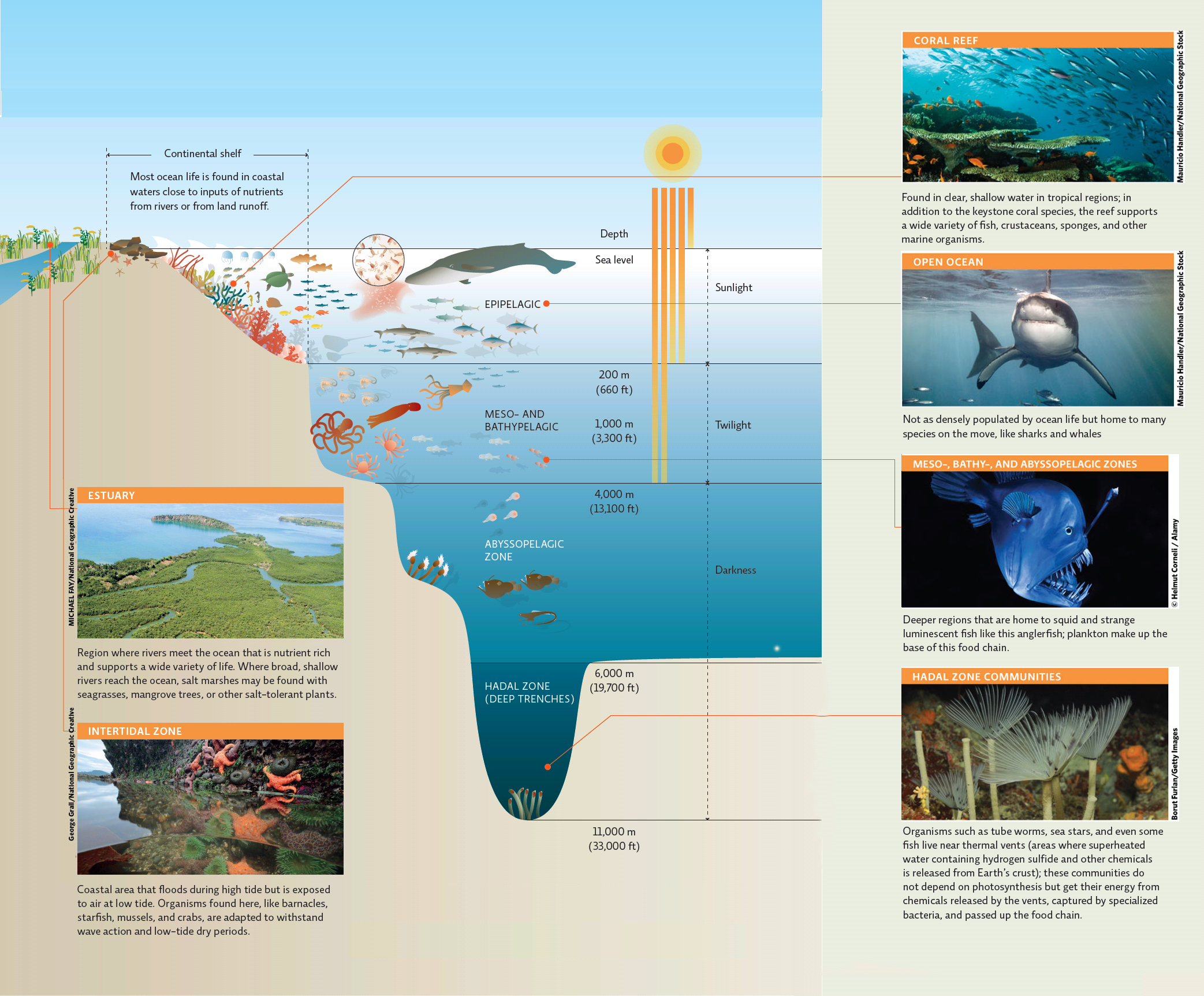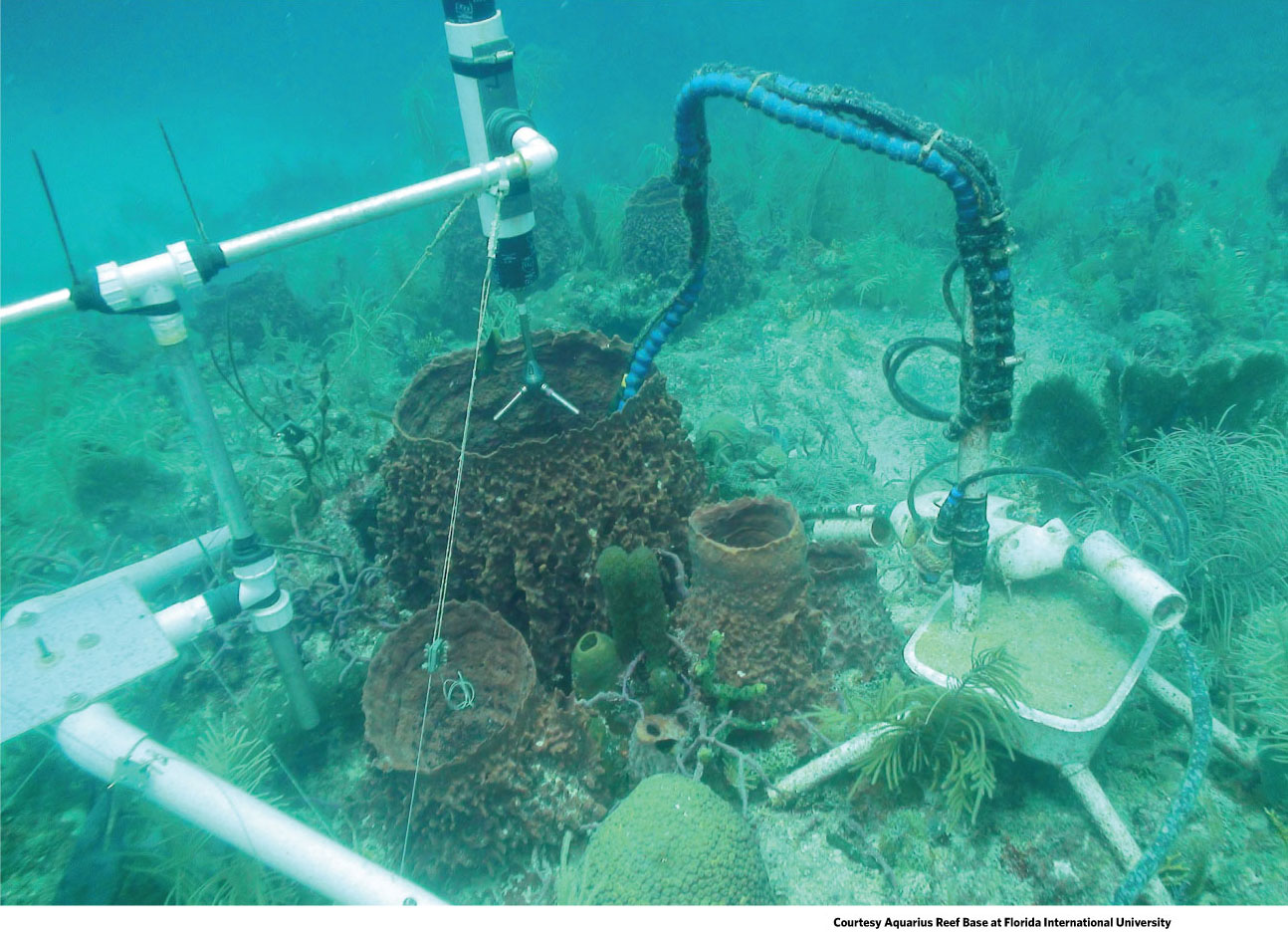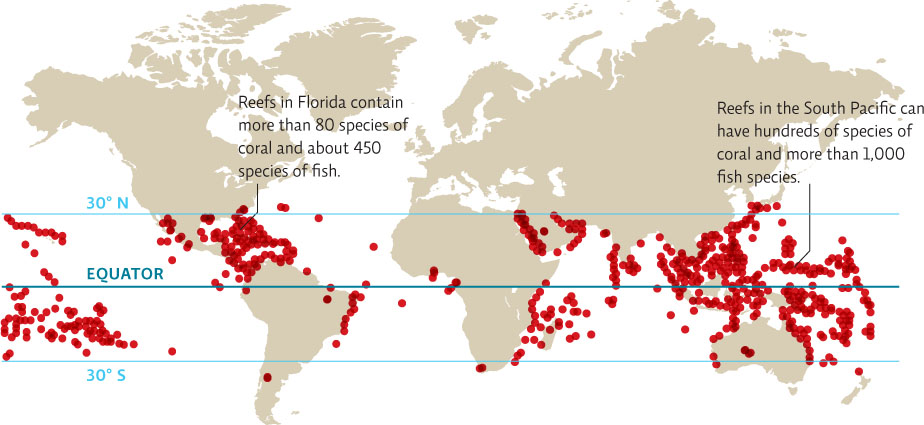Marine ecosystems are diverse.
The hidden crevices Slattery and his team were looking for are just one of countless ocean ecosystems. In fact, the world’s oceans are a wonderland of diversity. They cover about 70% of Earth’s surface and house a greater variety of flora and fauna than all land masses combined. In shallow, temperate regions, forests of tall brown seaweed known as kelp provide both food and habitat to a wide variety of organisms. Meanwhile, algae that cling to the underbelly of sea ice in the Arctic and Antarctic Oceans form the base of a food chain that ultimately supports whales and polar bears.
KEY CONCEPT 29.3
Marine ecosystems are tremendously diverse due to the varied conditions created by differences in depth, sunlight penetration, proximity to land, and latitude.
Lots of ecosystems means lots of ecosystem services, including temperature moderation (ocean water absorbs a lot of heat and releases it slowly), nutrient cycling, and support for large populations of commercially valuable fish. In particular, coral reefs are especially valuable for their services: protection of coastal areas from storms, purification of the water (many reef occupants are filter feeders), provision of recreational opportunities, and support of important commercial fisheries. They even serve as a source of current and potential medicines such as antibiotics and anticancer drugs. And oceans have absorbed a good bit of the CO2 we have released due to fossil fuel burning, reducing the atmospheric warming that CO2 would have caused if all of it had remained in the air.
Marine ecosystems, much like terrestrial ones, vary by location. In the ocean, depth is a key determinant of environmental conditions. About 80% of all sunlight is absorbed in the first 10 meters of the water column, and even more is absorbed in murky waters. Because sunlight supplies both heat and the essential energy for photosynthesis, upper layers of the ocean are much warmer and more productive than lower layers. In fact, most life-forms are found in shallow waters where light can penetrate; both heat and productivity dwindle further down the water column into deeper depths.
Scientists have divided the oceans into zones, based on depth. Each region differs in the amount of available sunlight, which in turn affects rates of photosynthesis and thus strongly impacts the diversity and abundance of ocean life at that level. Ocean regions are also identified by their proximity to land; the closer to land and to rivers that empty into the ocean, the more nutrient rich the area, and thus productive, the ocean community. In fact, estuaries, regions where rivers empty into the ocean, are known as the nurseries of the sea because many species come to these areas to spawn. INFOGRAPHIC 29.3
estuary
A region where a river empties into the ocean.
Different communities of species are found at different depths of the ocean and at different distances from shore. Most life is found on the continental shelf, the region off each shoreline that is relatively shallow compared to the deeper regions that begin at the edge of the shelf. Communities in deeper waters have life-forms adapted to little or no sunlight, whereas the most productive communities are found in relatively clear, shallow waters with ample sunlight.

MICHAEL FAY/National Geographic Creative
George Grall/National Geographic Creative
Mauricio Handler/National Geographic Stock
Mauricio Handler/National Geographic Stock
© Helmut Corneli / Alamy
Borut Furlan/Getty Images

Why is sea life more abundant in the waters above the continental shelf than in epipelagic regions of the open ocean or in deeper levels?
Sunlight penetration diminishes with depth so areas in shallower waters can deliver more sunlight to photosynthetic organisms on the ocean floor, thus supporting many more organisms at higher levels of the food chain. These areas also receive important nutrients from the rivers that empty into them as well as from runoff from coastal areas.

KEY CONCEPT 29.4
Most coral reefs are found in shallow tropical waters, but they all face major threats from overfishing, coastal development, pollution, and, now, acidification.
Coral reefs like the one that Slattery was studying are found in shallow tropical waters between latitudes 30˚ north and south of the equator. These reefs make up the most biodiverse communities in the oceans, some with more than 1,000 species of fish alone. But they are under attack from many forces: overfishing, coastal development, and pollution coming from land and sea. NOAA estimates that 75% of all tropical reefs are negatively impacted by human activity and environmental changes. Other species of coral live deep below the surface in icy, dark waters of temperate and tropical seas. These deep-sea coral form the basis of ocean communities as deep as 6,000 meters (20,000 feet) and are found in every ocean of the world. They too are threatened by overfishing and acidification as well as deep sea oil and gas exploration. INFOGRAPHIC 29.4
Most reef-building corals are found in warm, tropical and subtropical waters between 30° N and 30° S latitudes, indicated here with red dots. Coral reefs around the world are threatened by a variety of forces, and destruction of reefs is on the rise.

NOAA estimates that 75% of coral reefs worldwide are threatened by human activities or environmental changes. The two graphs below show the percentage of coral reefs already destroyed and the threats facing those that remain. Overfishing alters the community makeup, disrupting important relationships that keep the reef alive and healthy; heavy nets can also directly damage coral reefs themselves. Coastal development can add sediment to water, making it cloudy; in some areas, coral reefs are actually mined for limestone building materials. Pollution, whether from land or sea (ships), can directly harm coral as well.


What might explain why coral reefs in the Pacific Ocean are the least threatened reefs?
Either the threats themselves are less of an issue or protection is better in this area. Possible reasons include: coastal development and inland pollution reaching the reefs would not be an issue in these areas since they are away from major land areas (they are probably close to islands such as the Hawaiian Islands but not close to large land areas); overfishing may also not be as big a threat if these areas do not support large populations of commercially valuable fish; marine pollution may not be as big of a problem if these areas do not receive a lot of commercial ship traffic.